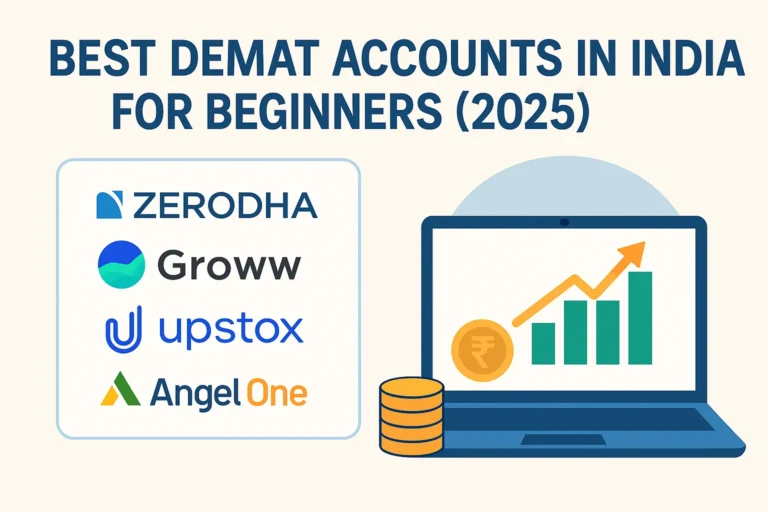How to Start Investing in Indian Stock Market (2025 Guide)
Investing in the Indian stock market has become more accessible than ever, especially with the rise of digital platforms and simplified regulations. If you’re looking to grow your wealth and take the first step towards financial independence, this beginner-friendly guide will walk you through the essentials of starting your stock market journey in 2025.
Why Invest in the Indian Stock Market?
The Indian stock market, powered by exchanges like NSE and BSE, offers a wide range of opportunities for wealth creation. Whether you’re aiming for long-term growth or passive income through dividends, stock investing can be a powerful tool to beat inflation and meet financial goals.
Key benefits include:
- Higher returns compared to fixed deposits or savings accounts
- Ownership in Indian companies
- Liquidity and transparency
- Compounding over the long term
Step 1: Understand the Basics
Before you invest, it’s crucial to understand key concepts such as:
- What is a stock? It represents partial ownership in a company.
- Stock Exchanges: NSE (National Stock Exchange) and BSE (Bombay Stock Exchange) are India’s two primary exchanges.
- Market participants: Retail investors, institutional investors, FIIs, etc.
- Types of investments: Equities, mutual funds, ETFs, IPOs.
Step 2: Open a Demat & Trading Account
To start buying and selling shares, you need two things:
- Demat Account: Stores your shares in digital format.
- Trading Account: Allows you to buy/sell shares on stock exchanges.
Documents Required:
- PAN card
- Aadhaar card
- Bank account with IFSC
- Address proof
- Passport-size photo
You can open accounts with brokers like Zerodha, Upstox, Angel One, Groww, ICICI Direct, and HDFC Securities. Most brokers now offer online onboarding in 10–15 minutes.
Step 3: Fund Your Account
Once your accounts are active, transfer money from your bank account to your trading account. This fund will be used to buy stocks. Start small—₹1,000 to ₹5,000 is enough to learn.
Step 4: Choose the Right Stocks
As a beginner, avoid complex strategies. Instead, focus on:
- Large-cap and blue-chip stocks with a strong track record
- Nifty 50 or Sensex companies
- Diversified sectors like banking, FMCG, pharma, IT
You can also start with Exchange Traded Funds (ETFs) or Mutual Funds if you’re not confident in picking individual stocks.
Step 5: Start Investing (Not Trading)
For beginners, investing (long-term) is safer than trading (short-term/speculative). Use a buy-and-hold strategy, and avoid daily price watching. The idea is to stay invested for 3–5 years or more.
Step 6: Track & Learn
Use stock tracking apps or your broker’s dashboard to:
- Monitor your portfolio
- Check stock performance and news
- Read financial reports
- Learn from your decisions
Also, make a habit of reading finance blogs, business news, and investor education portals like NSE India, Moneycontrol, or ShareMarketCourse.in.
Step 7: Avoid Common Mistakes
- Don’t invest based on tips or rumors
- Avoid penny stocks in the beginning
- Never invest all your money at once
- Set realistic expectations (10–15% returns annually)
- Keep learning before increasing capital
Final Thoughts
Starting your investment journey in the Indian stock market doesn’t have to be overwhelming. With the right accounts, tools, and mindset, you can begin small, learn steadily, and grow your portfolio over time. 2025 could be your breakthrough year to start building long-term wealth.
FAQs
1. What is the minimum amount required to start investing in India?
You can start with as low as ₹100 in mutual funds or ₹500–₹1,000 in stocks via brokers.
2. Is it safe to invest in Indian stock markets?
Yes, if you use SEBI-registered brokers and follow long-term investing strategies, it is considered safe.
3. Which platform is best for beginners in India?
Zerodha, Groww, and Upstox are popular beginner-friendly platforms.
4. Can I invest without a PAN card?
No, a PAN card is mandatory to open a Demat and Trading account in India.
5. Should I start with mutual funds or direct stocks?
If you’re not confident about stock selection, mutual funds or ETFs are safer starting points.



